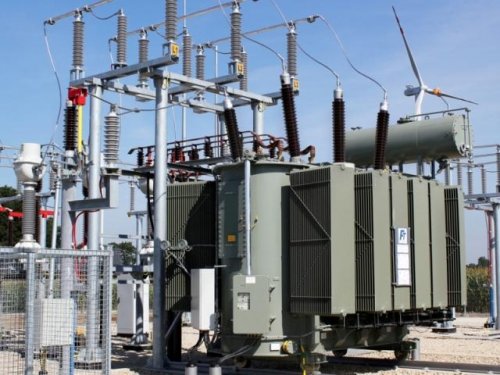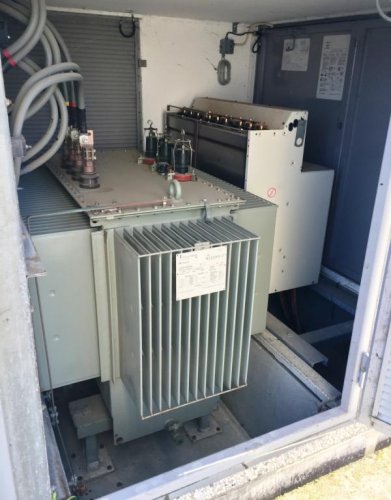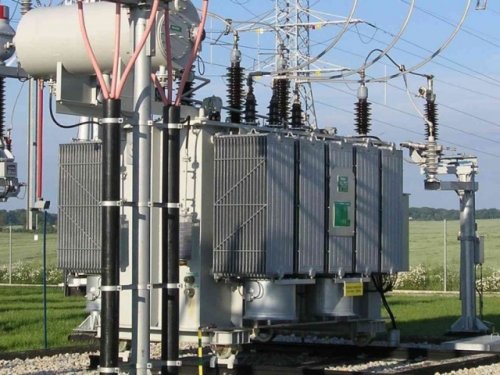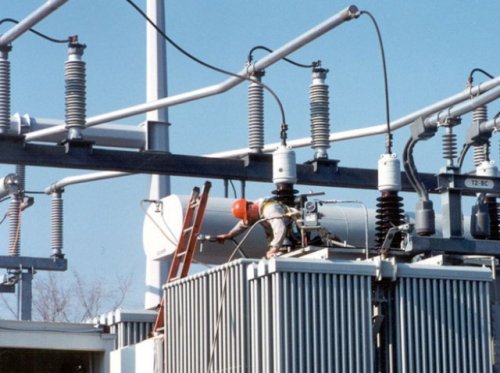Operation of power transformers
Power transformers are integral elements of the power system. These elements perform a very important function — they convert electricity from one voltage value to another value, which is necessary for further energy transfer or for supplying power to end users.
The most important task of the electric power industry is to maintain the normal and continuous operation of the equipment, including the power transformers, which can only be ensured by its correct operation. In this article, we will consider in detail the performance characteristics of power transformers.
Installation requirements for power transformers
First of all, it should be noted that the correct and trouble-free operation of power transformers is possible only if the requirements for its installation are followed.
Transformers with gas protection by design should be installed on the base of the equipment with a slight slope so that the upper cover of the transformer rises to the gas relay by 1-1.5%, and the oil pipeline to the expander by 2-4% . Transformers with rated power up to 1000 kVA, as a rule, are not equipped with gas protection, therefore they are installed without a slope.
The most important condition for the correct operation of a power transformer is compliance with the normalized temperature regime during its operation. Therefore, it is very important to fulfill all the manufacturer's requirements for the installation of the transformer. The main task in this case is to ensure the normal operation of the transformer under load, taking into account possible changes in the ambient temperature.
Transformer operating temperature
The operation of the transformer under normal temperature conditions is primarily ensured by the constructively provided cooling system. Accordingly, the normal operation of the power transformer is possible only if servicing and efficient operation of the cooling system.
If the transformer is installed in a closed chamber, then in addition to the standard cooling system, effective ventilation in the room must be provided. For transformers with small power, as a rule, natural ventilation is limited. Depending on local conditions, the characteristics of the power transformer and its capacity, forced supply and exhaust ventilation can be provided.The cooling efficiency of the transformer is determined by the temperature difference between the incoming and outgoing air — it should not exceed 15 degrees.
Heat dissipation from the windings of oil transformers is ensured by means of transformer oil in which the windings of this piece of equipment are placed. To avoid damage to the windings during operation, the required level of oil in the transformer tank must be observed. Therefore, the operation of the transformer provides monitoring of the oil level in the conservator of the transformer tank. The oil level must be within the permissible limits and approximately correspond to the ambient temperature, taking into account the current load of the transformer.
Also, transformers are equipped with thermometers or temperature sensors that monitor the temperature of the upper layers of transformer oil, which must meet the requirements of a certain cooling system.
Transformer load
Controlling the load mode is one of the most important tasks in the operation of a power transformer. The load current of each of the windings of the transformer should not exceed the nominal value. Light overloads are allowed, the size and duration of which depend on many factors - these data are indicated in the operational documentation.
Prolonged overloading of transformers beyond permissible standards negatively affects the life of the transformer.Therefore, in the event of a power shortage, the transformer must be replaced with a more powerful one that meets the current needs of consumers.
In case of seasonal changes in the loads with no power, an option to solve the problem would be to install an additional transformer which, if necessary, involved in parallel work… It is possible to connect transformers for parallel operation only if several conditions are met:
-
equality of coil connection groups;
-
the ratio of the rated power of the transformers is no more than 1 to 3;
-
equality of nominal voltages (0.5% difference between transformation ratios is allowed);
-
equality of the short-circuit voltage (a deviation of 10% is allowed);
-
observance of phases when connecting the coils.
Fire safety in operation of power transformers
Power transformers are equipment with an increased risk of fire. Therefore, during the operation of power transformers, it is necessary to strictly observe the fire safety rules.
In a closed chamber or on the territory of an open switchgear where the transformer is installed, there must be the necessary fire-fighting equipment — boxes with sand, fire extinguishers.
Special automatic fire extinguishing installations are installed for high power transformers. In this case, the operation of the transformers includes periodic checks of the operability and maintenance of these installations.
For transformers with a large volume of transformer oil, in order to avoid oil splashing in the event of a leak in the tank, special oil receivers are installed, which are connected by pipelines to an oil sump tank. If the transformer is damaged, the entire volume of oil will enter the oil pan.
In energy facilities, special attention is paid to the training of service personnel on fire safety issues: training is organized, knowledge of fire safety rules is periodically checked, fire training is conducted and special fire extinguishing schemes are developed, taking into account local conditions.
Protection of power transformers
The operation of power transformers within the declared service life is ensured by the presence of protective devices, the main task of which is protection of transformers from unwanted overloads and internal damage.
Therefore, operation of transformers also includes timely inspection and maintenance of relay protections and transformer automation elements.
How power transformers are operated in power facilities
To ensure continuous and long-term operation, the operation of power transformers at substations includes the following measures:
-
performing periodic inspections of the equipment;
-
performing scheduled maintenance and overhaul;
-
troubleshooting after emergencies.
The frequency of inspection of transformers depends on the type of electrical installation.In electrical installations with permanent staff on duty, the inspection is carried out once a day, without permanent staff - at least once a month, and inspection of transformers in distribution points - once every 6 months.
Depending on the operating conditions of the transformer, in particular the load mode, the ambient temperature, as well as the technical condition of the equipment in general, the frequency of checks may change.
In case of emergency situations, after activation of the protection or a sudden change in the ambient temperature, extraordinary checks of the transformer are carried out.
Transformers are checked without turning them off. When checking a power transformer, the following is checked:
-
readings of temperature sensors, the level of oil in the expander and the correspondence of these data with the average daily temperature of the environment, taking into account the magnitude of the load on the power transformer;
-
the absence of external crackling inside the transformer tank, noises that are not typical for the normal operation of the transformer;
-
the integrity of the grounding conductor (bus);
-
the integrity and absence of contamination of bushing insulators, oil pressure and absence of leaks with sealed bushings;
-
the condition of the busbars and contact connections, the lack of their heating;
-
no oil leakage on the transformer tank, pipelines and other structural elements;
-
the condition of the signal silica gel in the air dryer;
-
serviceability and proper operation of oil treatment equipment, cooling devices;
-
in the presence of a load switch - compliance with the position of the switch of the drive switch located on the transformer and the indicator located on the protection, control and automation panel;
-
also on the protection panel, the readings of the devices are checked — the load current and voltage levels on each side, the absence of external signals from the protection and automation, the correspondence of the positions of the switching devices to the normal operation of the equipment.
Operation of transformers also includes control of voltage levels in the consumer. In case of voltage deviation outside the permissible values, the voltage is adjusted by switching the winding taps through off-circuit tap changers or load switching devices.




